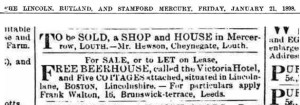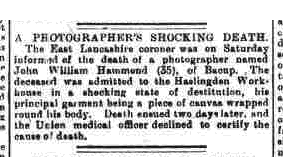Frank Walton 1833 – 1923 – the oldest showman in England
Photographic Business
According to Frank Walton in 1921, he specialised in photography ’63 years ago in the days of the old, wet collodion plates’ (i.e. 1858), otherwise known as ambrotypes. At the time he was a travelling showman and later went on to have several travelling studios operated by himself and others.
However, he appears to have first advertised in trade directories in 1871 in Grantham, Lincolnshire.
During his time as a photographer he operated studios in Grantham, Boston, Manchester, Leeds and Southport as well as running other types of business at the same time.
Frank Walton was commercially active for fifty years until 1910 with his last studio at his home, Elm House at No.13 Crimbles Street, in the Meanwood district of Leeds. He retired in 1910 aged 76 years.
Frank died in Leeds in 1923.
Census
1841 – age 7, at Frog Lane, St Mary’s Islington, Finsbury, London
1851 – not traced
1861 – age 29, in a caravan at Mars Yard, Gainsborough (occupation – bazaar keeper). Born in London
1871 – age 36, at High Street, in Booths, Grantham, Lincolnshire (occupation – photographer and confectioner). Born Islington, Middlesex
1881 – age 46, at Corner of Harrison Street, St John’s, Leeds West (Caravan) (occupation – photo artist)
1891 – age 55, at 51a New Briggate, Leeds (occupation – photographer). Widower.
1901 – age 63, at 13 ? Street, Halifax (occupation – inn keeper, employer)
1911 – age 74, at 13 Crimbles Street, Meanwood, Leeds, Yorkshire (occupation – photographer)
1921 – age 86, at 13 Crimbles Street, Meanwood, Leeds, Yorkshire (census not yet released)
Frank Walton was known as ‘the oldest showman in England’.
1833 Frank Walton was born on 12th October 1833 at Frog lane, Islington, Middlesex and lived with his father, John Walton (b. 1804, place unknown), and his mother Mary Anne Walton (nee May).
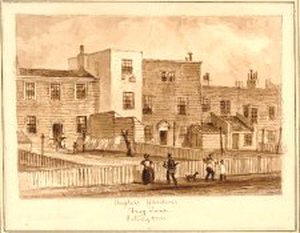
Frank Walton’s birthplace – Frog Lane, Islington, Middlesex. 1834.
1834 Frank was baptised on the 24th May 1834 at St. Mary’s Church, Islington in Middlesex.
Frank had five siblings, three older and two younger. They were Georgiana Walton (born 1828 died 1917), Thomas John Walton (born 1830 died 1907), Walter Walton (born 1832), Harry May Walton (born 1837 died 1839) and Emily Mary Walton (born 1838 died 1912 – a spinster) but in 1840, when he was only six years old, his mother died in childbirth at the age of 35 (presumably the child died as well).
In 1841, when he was seven, the census shows that Frank Walton was still living at Frog Lane, St. Mary’s Islington, Finsbury, London with his father and three older siblings.
In 1842, Frank’s father John Walton married again. This time to Frank’s new step-mother Mrs. Ann May (nee Suett) widow of Mary Anne Walton’s brother Joe May. A step sister, Mary Ann Walton, was born and died in the same year and another step sister, Marian Sarah Walton, was born in 1844 and she lived until 1935.
Frank has not been traced yet in the 1851 census.
The origins of Frank Walton’s association with photography can be gleaned from interviews he conducted with the Yorkshire Evening Post on the 19th May 1921 when he was 87.
Frank was quoted as saying “I was travelling with Gingerbread and other stalls, when I was quite a lad; I am a Londoner, and I remember well the big fairs that used to be held at Camberwell and Woolwich which were done away with long years ago.” According to Frank, he specialised in photography “63 years ago” – in 1858 – “in the days of the old, wet collodion plates”, otherwise known as ambrotypes which were underexposed glass negatives backed with black velvet or shellac. With a positive effect then created, pictures were normally clear and sharp and were usually presented in a frame or case.
Itinerant photography was far from easy – the ambitious young photographer had to consider the weather, use a pocket watch for timing, judge the right exposure time and often use a hat to shade the lens – no wonder sitting for a picture was often handled by theatrical showmen and artists.
1858 On the 3 March 1858, Frank married Mary Anne Reeve Shaw (daughter of William and Elizabeth Shaw, farmer from Wisbech in Cambridgeshire) in Kings Lynn, Norfolk and soon moved to the nearby town of Grantham to run a bazaar with help from his step-sister Marian Walton and step-brother-in-law, Robert Hammond, both in their teens.
1859 Their first daughter, Louisa Walton, was born in 1859 in Coventry, Warwickshire. There is no trace of Louisa in the 1861 census but in 1871 she was in Boston, Lincolnshire aged 10 years and living as a grandchild with her sister Emily (7 years) and grandmother, Elizabeth Shaw, a 69 year old widow, and a fruiterer. By 1881, Louisa, aged 21 years is a photographer, still living with her sister, Emily (18 years) and grandmother, Elizabeth Shaw now 80 years (census rounding) a beer house keeper, running a public house owned by Frank Walton. Louisa and Emily managed the Boston Studio of ‘Frank Walton’ Photographers. Louisa married George Archer Blanchette , a comedian, on the 30th January 1883 in Boston, Lincolnshire
By 1861, at the age of 29, Frank was living in a caravan at Mars Yard, Gainsborough with his wife Mary Ann, his step sister Sarah , his brother-in-law Robert and a 12 year old servant, Henry Cousins, who were all waiters in the bazaar. Frank’s occupation was recorded as a bazaar keeper.
1862 Frank’s second daughter, Emily Walton, was born in 1862 in Gainsborough, Lincolnshire. In 1871 she was aged 7 years and was with her grandmother, Elizabeth Shaw in Boston, Lincolnshire and in 1881, aged 18 years, she was still with her grandmother and was listed as a photographer.
Frank gradually established himself as a travelling photographer during the 1860’s visiting fairs and feasts from his base in Grantham.
1865 Life was not always smooth in the world of travelling entertainers. This article in 1865 shows clearly that Frank Walton was already describing himself as a photographic artist at the age of 30 when just married and residing in Grantham. Henry Hammond was the younger half-brother of Frank’s wife Mary and was just 15 years at the time of this incident. Henry went on to become a successful photographer in Mexborough in Yorkshire.
“Committal of the Juvenile Burglars” January 27th, 1865 – The Lincolnshire Chronicle
On Saturday morning last, Frederick Fields, Henry Hammond and William Coulson, who had been remanded from the previous Tuesday, were again brought up at the Police office, charged with breaking into the shop of Mr Frederick Smith, bread and flour dealer, Bridge Street on the night of the 16th instance, with intent to commit felony………………..
The Prisoner, Henry Hammond, who was removed from the dock, and placed in the witness box, said,
“I live with my mother who is a Fruiterer, and assist her in the business. I know the prisoner, Fields, and have been on friendly terms with him for some time. On Tuesday week, about a quarter to eight in the morning, I met him by appointment at the top of Dolphin Lane, and he asked me to go to Spalding and get a £5 note changed. He gave me the note and 3 shillings to pay my way there and back. I did not go to Spalding. When Fields went to his work, I returned up town but did not give him the note. I, afterwards, got it changed, by Mr Walton, Photographic Artist at Bargate Green. Fields and myself owed him some money, and I paid him 50 shillings, and he returned to me the other 50 shillings. I knew nothing of the robbery until after it happened.”
Frank Walton said,
“ I am a Fruiterer and Photographic Artist and know the last witness, Hammond. On Tuesday week, he brought me the £5 note produced to pay me 50 shillings, Hammond and Fields having bought my booth. The 50 shillings was in part payment for the same. I afterwards gave the note to Superintendent Waghorn.
By 1870, he worked in Grantham from booths in the high street whilst still maintaining his primary income through the family trade of confectionery. Frank had learnt early on that showmen and hustlers made their money by tricking the eye, and access to new technologies made this idea develop significantly. Major developments in the area of both optics and printing helped photography at the fairs become much more popular, cheaper and quicker. Before long, images would be viewed one after another giving the impression of movement.
His brother-in law, Robert Hammond, married to Mary at the age of 23 in 1866, and still involved with Frank in offering photographic services at the travelling fairs with what became known as the ‘Hammonds Van’, settled down by 1870 and moved to the town of Bacup in Lancashire where he opened the first of several studios, including one in Accrington.
Meanwhile, his younger brother Henry Hammond and wife Elenor also took up photography as a profession in Mexborough in Yorkshire.
By 1871 Frank was advertising his studio in the High Street, Grantham, Lincolnshire
Through the 1870’s, with his girls, Louisa and Emily staying mostly in Boston with their grandmother, Elizabeth Shaw, Frank and Mary acquired several travelling studio’s which would attend at all of the fairgrounds across the north. At this time, Frank worked with the cheaper, poorer quality tintypes.
1874 In November 1874, it was reported in the Leeds Times that Frank Walton was charged with receiving a stolen horse and was committed for trial on two sureties of £50 each. See below.
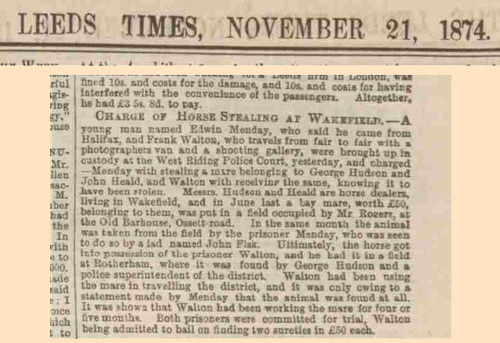
Report of Frank Walton charged with receiving a stolen horse – Leeds Times 1874
During the period 1878-1882, with his daughters Louisa and Emily Walton now having left school and growing up, he opened a photographic studio in Boston where they were based. They both trained as photographers and ran the studio until their respective marriages in 1883.
1881 Frank also advertised his services at the Stretford Road, Manchester in a trade directory in 1881. It is not known if this was a permanent studio or not.
Frank continued to use tintypes when, in 1878, he set up a studio in the busy city thoroughfare, at 28 New Briggate in Leeds. The studio stayed open until at least 1903. Frank advertised his business as ‘Walton’s Victoria Carte-de-visite’ and reminded customers that photographs could be taken and finished in a few minutes, without the aid of light, and could be enlarged to any size and finished in any style.
Two years later, Frank and Mary Ann, now both in their mid-forties, were still closely linked to the travelling shows, living in caravans at the corner of Harrison Street, which connected with New Briggate, neighbours of the Best family from Huddersfield, who were proprietor’s of a fairground shooting gallery. Frank had employed an assistant by this time, Thomas Platt, who together with their domestic servant, Mary Ann Tyler, hailed from Wisbech and Boston respectively.
By 1880, Frank had started to refer to himself purely as a ‘Photographer’ or ‘Photo Artist’ and confectionery had taken a back seat for good. Soon Frank started to build a big studio on the same corner of Harrison and Briggate, later replaced by a garage. His business was registered with the Institute of Photography and the Repository of Art.
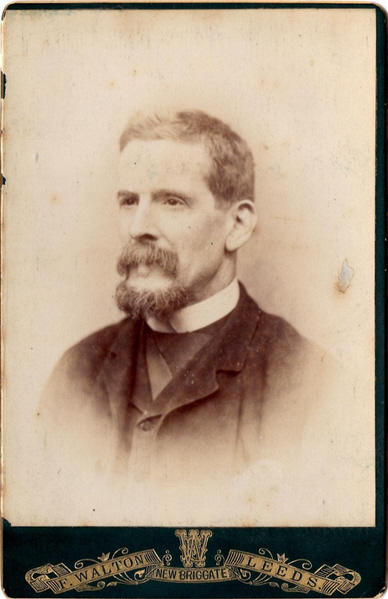
Frank Walton – self portrait
1882 saw preparations for the marriages of both Louisa and Emily.
Louisa married a young twenty-six year old comedian, based in Lambeth, called George Archer, son of Kent farmer, Tom Blanchett. They married in Boston at the start of 1883. George Eugene Belmont aka ‘Barnum’s Beauty’, who, following a career with the ‘Brothers Belmont’, became theatrical agent and manager of Sadler’s Wells and well as other music hall theatres in both London and Manchester, in proprietorial partnership with Frank, and Emily’s brother-in-law from Hull, valuer and auctioneer, Arthur Greasley. He brought the first Cinematograph to Sadler’s Wells, and gave the darling of the halls, Marie Lloyd, her first professional engagement on stage at the Sebright Theatre in Hackney in the mid 1880’s. Louisa died from heart failure in 1900 at the age of only 39.
Emily’s marriage followed at the end of 1882 in Wakefield, marrying Thomas, son of Thomas Greasley, a recently widowed Yorkshire auctioneer. Thomas was employed as a hotel-keeper and licensed victualler at the Golden Cross Hotel, Porter Street, Kingston upon Hull. Emily also died young of typhoid fever in 1888, just six years after getting married. She was only 25.
Whilst developing his photographic studio’s, Frank also busied himself as a member of the ‘United Van Dweller’s Protection Association’ (U.V.D.P.A.) whose rule stated the main objective as being to watch any attempt at legislation calculated to affect or interfere with the rights or business of Showmen and Van Dwellers. Simultaneously, by the mid decade, he commenced running a fair on the old drill ground at Camp Road in Leeds.
1885 saw Frank and Mary become grand-parents as their youngest daughter Emily Greasley had a son who was named Frank Walton Greasley in his honour. Hotel and theatre ownership started to be added to Frank’s list of business activities, so much so that Archer and Louisa went south to Brighton to manage a public house there as joint licensed victualler managers. Other pubs followed in Boston, Hull and Scammonden (near Huddersfield) managed by half-sister Marian Smith, formerly Stewart, (nee Walton) and husband Tom.
In 1886 a further studio was advertised at 24 New Briggate in Leeds and it was still being advertised in 1889. He advertised a further studio at his home address, 51a New Briggate, Leeds in 1887 and continued to do so until 1898.
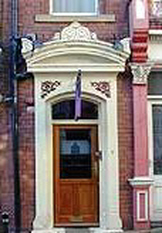
Frank Walton’s home and studio at No. 51 New Briggate, Leeds
1887 Frank made arrangements with a group of Greek gypsies as part of an exhibition but fell out over the sharing of profits. He took the gypsies to court as follows.
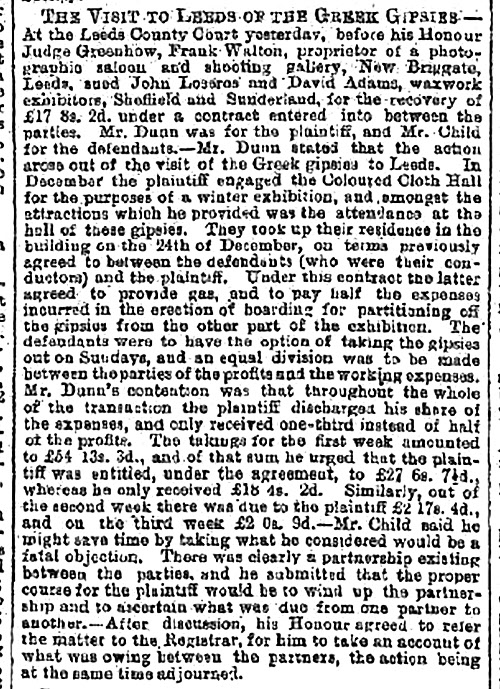
Professionally, Frank Walton was becoming much more successful in the late 1880’s but tragedy struck twice with the death of both his wife, Mary Ann in her fifties, and his daughter Emily in 1888, who was only twenty-six, the latter event leaving his son-in-law, Tom Greasley, widowed for a second time. Frank naturally developed a strong bond with his three year old grandson Frank from this time and for the rest of his life.
The 1870’s had seen a resurgence in the use of the gem tintype process, popular in North America, largely explained by the rapid expansion of chains of American style studio’s owned by companies Anglo-American Photo and American Gem. In the 1880’s Frank began to use the term ‘American Studio’ in his promotional information and it was applied to all four of his locations – Leeds, Southport, Boston and Manchester. Tintypes were the least expensive type of photograph and an established studio like Walton’s of Leeds and Manchester could sell at three cartes de visite mounted tintypes for a shilling, eight for two shillings and twelve for half a crown! Tinting was an extra penny per picture.
In 1891, Frank, now a 56 year old widower, was still living comfortably at 51a New Briggate. Staying with him in the house was his mother-in-law, Elizabeth, now eighty-six, a servant, Merrion Chantley, and visitors, sister-in-law, Edith, daughter Louisa and grandson Frank.
In 1892, Frank was still advertising Fairs – see below.
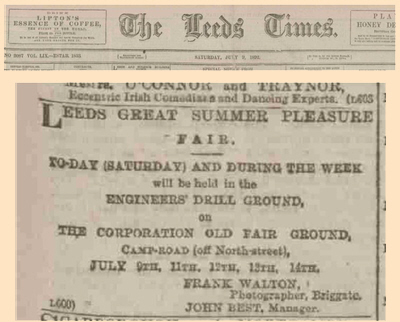
Leeds Times advert for Fair at Engineers Drill Ground, Leeds in 1892
1893 By March 1893 Frank’s partnership with the aforementioned Arthur Greasley, his son-in-law’s brother, was dissolved and notified in the Huddersfield Daily Chronicle – see below. Frank was noted as a ‘licensed victualler’.
![]()
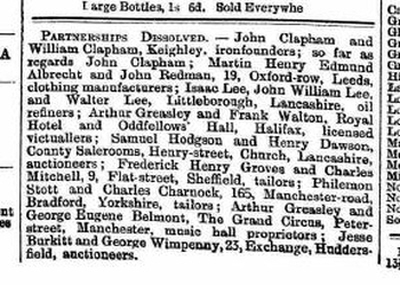
Notice of partnership dissolution Huddersfield Daily Chronicle 1893
1894 There’s a good chance, Frank would have known of the widowed Mary Bailey, daughter of George Brewer, a farmer from Bath in Gloucestershire, long before they decided to get married on the 22nd March 1894 in Halifax. Mary had first been to Leeds in 1851as a young girl in the showground business. Mary was quoted as saying ‘It is a business one must be brought up to; to succeed at it’. Mary’s deceased husband, Henry Bailey, had been a travelling showman.
Frank had started to extend his interests in other branches of the visual arts by this time and was investing with stock companies in theatres, an example of which was the Oddfellow’s Hall in Halifax. Frank became the proprietor and employed John Gibson as his manager and correspondent. A typical show, taken from a surviving programme, included a full evening’s entertainment commencing with an overture by the house band, followed by ventriloquists, Anglo-American comedians, Parisian marionettes and pantomimists, then an interval and, a mimic and musical impressionist, high kicking dancers and a burlesque actress fresh from the Alhambra and Tivoli before ‘God Save the Queen’ was sung at the end!
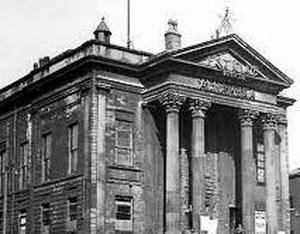
Frank and Mary Walton’s theatre at Oddfellows Hall in Halifax
Photographic booths, ghost illusion shows and other visual exhibitions all played a role in the history of the fairgrounds. From the mid 1800s, photographic booths were popular attractions at many local fairs (there were a dozen photographic booths at Lincoln Easter Fair in 1896) and many travelling photographers were from traditional fairground families. Ghost illusion shows and other optical entertainments were popular before the bioscope shows took over the fairgrounds in the late 1890s.
1897 – 1899 Various references to Frank’s and Mary’s activities appeared in publications as follows
- 1897: Ilkley Feast: Walton with his photo booth converted into a cinematograph exhibition (Barnes, J. Beginnings of The Cinema in England: Vol.2: 1897: p177)
- 1898: Shipley Feast: Bailey and Walton’s living pictures (The Stage, 13 Aug 1898)
- 1899: Halton, Leeds: Bailey’s Bioscope (Vol. IX, No. 6, October, 1956)
1898 As Frank prepared to wind down his business activities he advertised that his Victoria Hotel in Boston was for sale or sub lease – the sale included five cottages. The advertisement is shown below.
In 1901, John William Hammond, Frank Walton’s nephew who had a studio in Bacup, died in very unfortunate circumstances in the workhouse at Haslingdon. A newspaper report below gives further details.
By 1900, Frank and Mary had moved to Halifax where Frank bought a public house and set himself up as an innkeeper at No. 13 Market Street. Grandson Frank and step-daughter, Grace lived with them for a while.
The years in Halifax, before Frank and Mary retired must have been exciting and rewarding professionally. Mary had started life as a daughter of a poor tenant farmer in Gloucestershire, being whisked off her feet by the travelling showman from East London, Harry Bailey. In 1921, she was quoted as saying ‘I’ve been on every fairground twixt John O’Groats and Land’s End ! I well recall being at Holbeck feast when they used to hold a race meeting there’. Henry and Mary had jointly developed and run the Bailey’s Ghost and Marionette show (Bailey’s Ghost Show: Hunslett Feast, 1897 (Merry Go Round, Vol. IX, No. 6, Oct, 1956), a one-time famous travelling concern. ‘The marionette was the forerunner of the cinema. Young and old rejoiced in it. Its vigorous action, the quaint movement of the little figures, or their headlong dashes from one side of the stage to the other, never failed to provoke merriment’ stated the Leeds Mercury interviewing Mary in 1924. Mary’s daughter, Tilly, was quoted as saying that ‘the show was by no means, an insignificant affair with dozens of figures on the little stage at a time, and regular pantomimes like Red Riding Hood and Sinbad the sailor were given. We used to give as many as between 20 and 30 shows a day at the fairs, and we had a crowded tent as a rule’. With twenty-three children and 127 descendants, Frank had found a formidable second life partner.
Fairgrounds were not only responsible for the rapid expansion of affordable photographs and entertaining shows, they popularised what were then known as ‘living pictures’, bringing early cinema to the British people. Frank’s interest may well have started on either witnessing or hearing of Randall Williams Bioscope show at the Hull Fair in October 1896. It caused a sensation ! These were excellent occasions to see the latest public figures on celluloid and also ‘seeing yourself as others see you’, a popular slogan of the time. Other northern showmen were also passionate about the new medium – especially Frank Mottershaw from Sheffield who travelled the fairs with his cinematograph equipment. In his 1921 interview, Frank claimed that ‘I’ve done most things in the showman’s line. I brought the first cinematograph show into Leeds!’ A surviving advertising poster, probably from the turn of the century, is headed ‘the Walton and Bailey Grand Exhibition – nothing like it ever seen before’, and ‘marvellous Cinematograph or Living Pictures’. The poster continues to explain further what will be witnessed, ‘pronounced by the press as the perfect production of this most wonderful, scientific discovery yet presented; every picture teaming with life and motion’. The main act of the cinematograph was, on this occasion, supported by a renowned highland dancer named Mr. E P Stuart from Ayr, winner of 175 prizes and with 17 appearances in front of Queen Victoria up to 1889, presumably at Balmoral ! The event was for all members of the family and film reels and subject matter were changed daily. Children were charged one penny and adults, thruppence ! The heyday of the cinematograph shows held at fairs or in theatres was between 1906 and 1912 as, by the latter date, cinema’s were being built rapidly around Europe.

Walton and Bailey Cinematograph Exhibition
1904 Shortly, after 1904, Frank and Mary returned from Halifax, closed their studio in New Briggate and sold their home to move to the suburbs at 20 Carr Road, Leeds where Frank set up a smaller studio. The studio was advertised in 1907.
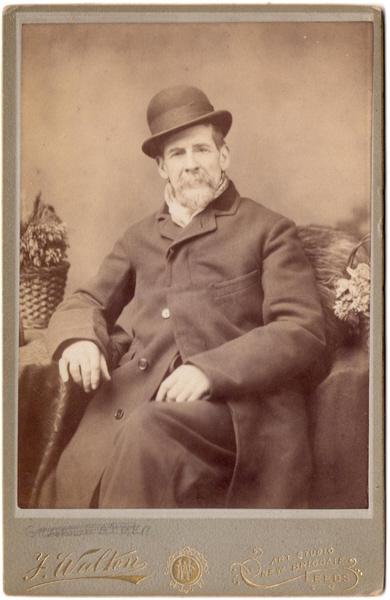
Frank Walton – self portrait
1909 He continued to work for about two more years before selling Carr Road and buying Elm House, a five roomed property at No. 13 Crimbles Street in the Meanwood district of Leeds which he advertised in trade directories in 1909 and 1910.
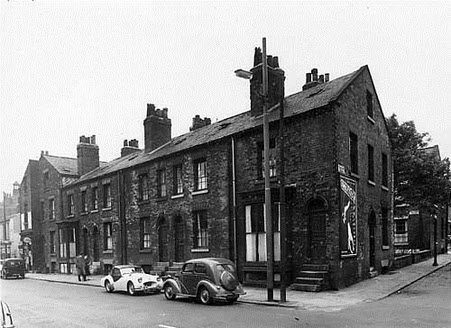
Crimbles Street, Leeds
1910 No. 13 Crimbles Street turned out to be Frank’s last registered studio address in 1910 and where he and Mary remained until their respective deaths in 1923 and 1925. It is likely during this period that Frank, who appeared to have been an astute businessman, divested some of his financial interests in several public houses, theatres and studio’s and converted the proceeds into capital which he invested.
Frank Walton was commercially active for forty years until 1910 with his last studio at his home Elm House at No.13 Crimbles Street, in the Meanwood district of Leeds. He retired in 1910 aged 76 years, having outlived his London based elder brother Tom, a confectioner, who died in London in 1907.
The 1911 census shows Frank, 74 years old and still described as a photographer, and Mary, 75 years old, living at 13 Crimbles Street, Leeds with a 64 year old visitor, Sarah Brewer, a widow who had been born in the Shetland Isles, Scotland.
1912 Frank’s sister, Emily Walton, a spinster who never married, died in 1912 aged 67 and Frank’s elder sister, Georgiana Constable, passed away in 1917 aged 89 years. Frank’s step-sister, Marian Stewart remarried as Marian Smith and lived until 1930 in the East End of London.
The loss of his second daughter, Louisa Blanchette in 1900, with no children surviving her, was another blow, although Frank continued to support Archer Blanchette, who remarried and remained a London publican – managing the ‘Marquis of Granby’ in Shaftesbury Avenue from 1910 to at least 1915. Meanwhile his other son-in-law, Tom Greasley and his new wife Susannah continued as managers of the hotel in Hull.
Frank and Mary retained their closeness to Mary’s family – particularly Matilda or ‘Tilly’ Barnes, Jane Bates and grandchildren, Daisy Bailey, Lily Hammond and, of course, Frank Greasley.
1918 These and others were remembered in Frank’s various wills and codicils written between April 1918 and his death five years later. Jim Tinsley of Bentley near Doncaster was to receive ‘the Missuss Van’ and all photographic apparatus with it; Tom Yeadon or Eyden of West Hartlepool was to receive ‘the Hammond’s Van’ and all apparatus. Both Tinsley and Yeadon were at some point renting the Vans from Frank to run the travelling studio’s across the north of England.
1920 Eighteen months later in late 1920 these bequests to Tinsley, Yeadon and Mrs Clay, a local friend, were revoked by Frank in a codicil.
1922 Meanwhile in 1922 Frank and Mary gave a very interesting insight into their lives via a newspaper interview.
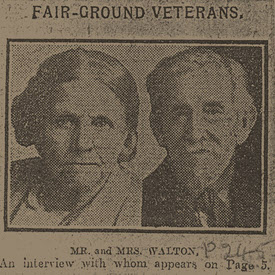
Frank and Mary Walton – their newspaper interview 1922
|
Oldest Showman Tells his Story – 12 October 1922 A lifetime spent on the fairgrounds An old Leeds couple ________________________________________________ Cocoanut stands that do duty in a garden Planted in a Leeds garden as supports for such plants as manage to survive the industrial atmosphere of the city are several rows of old iron rods with a ring on the top. They are unmistakably stands which once did duty on a fairground stall for holding the cocoanuts which are so hard to knock off. The garden is that of an early Victorian house in Crimbles Street – Elm House – where live two old folks who are surely one of the most interesting couples in England. As far as is known they are two of the oldest fairground show people in the world, for Mr Frank Walton is 90 years of age today, and his wife is nearly 94. Bothe entered the showman’s business as children, and as they only retired about 10 years ago – Mr Walton owns a van yet – they have spent a long lifetime on the feast and fairgrounds of England. What memories must be stirred by the rusting cocoanut stands in the garden! The door was wide open this morning and a gentle knock was answered by a women’s deep voice, speaking with the distinctive West country accent rarely heard hereabouts. “Master”, said the voice, ” don’t you hear someone knocking at the door?” A white haired old man with a kindly face came to the door, and a few minutes later the old couple were living their lives over again – talking of “the grand old days of the fairground”. They are a wonderful old couple. “The Master”, as his wife invariably refers Mr. Walton, is is able to knock about nicely; but the clearness of his eye, and his good memory are as naught a compared with the faculties of his wife, with her strong face, clear of wrinkles as that of many a woman half her age, her excellent hearing and sight, and her ready wit. “Yes”, said the old man “ninety today, and I was travelling with gingerbread and other stalls when I was quite a lad. I am a Londoner, and I remember well the big fairs that used to be held at Camberwell and Woolwich, which were done away with long since”. Ran a Theatre I’ve done most things in the showman’s line he added. “I brought the first cinematograph show into Leeds. I used to run a fair on the old Drill Ground in Camp Road, which I rented and let off to the other showmen. Then I specialised in photography 63 years ago in the days of the old wet collodion plates, and besides running five travelling studios around the various fairgrounds. I built a big studio at the corner of Harrison Street and Briggate where a garage now stands. I also ran a theatre years ago with the old stock companies in the Oddfellows’ Hall at Halifax. But my wife was more in the show business than I was”. The old couple were married about 35 years ago but both had previously been married. “It must be seventy years since I was first married” said Mrs Walton “for my daughter Tilly is 68 and Jane is 66 – that makes a total of 227 for a mother and two daughters. I’ve had 23 children and altogether I have 127 descendants”. Mrs. Walton was formerly Mrs. H Bailey, proprietoress and manageress of ‘Bailey’s Ghost and Marionette Show’ a one time famous travelling concern. “I’ve been on every fairground between John O’Groats and Land’s End. I well recall being at Holbeck Feast when they used to hold a race meeting there”. |
1922 In late 1922, a further codicil made several further changes to Frank’s will, showing his further change of plan. He increased the weekly income for Mary after his death, he had decided that he wanted his remains to be interred in the family vaults at Hull, to which he may have been referring to his daughter, Emily Greasley’s burial location, and he added in a number of new legacies from the nearly £7,000 that he left.
To Jane Yates, formerly Bates, nee Bailey, to Rose Bowers, a long time servant, to Tilly Smith, formerly Matilda Barnes nee Bailey, to Merian Smith formerly Stewart nee Walton, and to Grace or Sarah Brewer another servant. To Oswald Matthewman, a friend and to his Solicitor, Walter Tempest, he added a bequest. To Henry Bailey Junior and Frank Greasley – all debts from loans were cancelled, plus Frank was given two travelling photographic studio vans – one based in Scarborough in 1922 and one behind Elm House! Frank Greasley was by now 35 years old and had served in the army in the first world war, but had not followed his grandfather into photography, so it is assumed he sold the vans. The final element of change in the will was to revoke significant bequests for Marian and his great-nephews, Henry and Albert Walton, grandsons of his brother Tom, in favour or his grandson Frank.
1923 Four months later, on the 5 February 1923, Frank passed away at Elm House of old age and heart failure aged 91 years having been a rich photographer, confectioner, theatrical impresario, and licensed victualler.
Frank was at one stage proprietor of the Grand Theatre in Manchester, the Sebright Theatre in London as well as the Oddfellows Hall in Halifax. He was also the Licensed Victualler of the March of Intellect and Golden Cross Hotels/Pubs in Hull where he was buried at his own request.
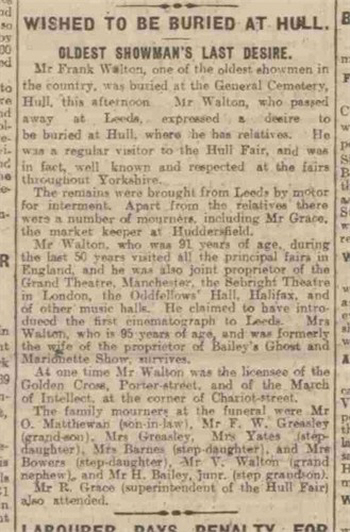
Report of Frank Walton’s burial at Hull
Two of his obituaries are shown below.
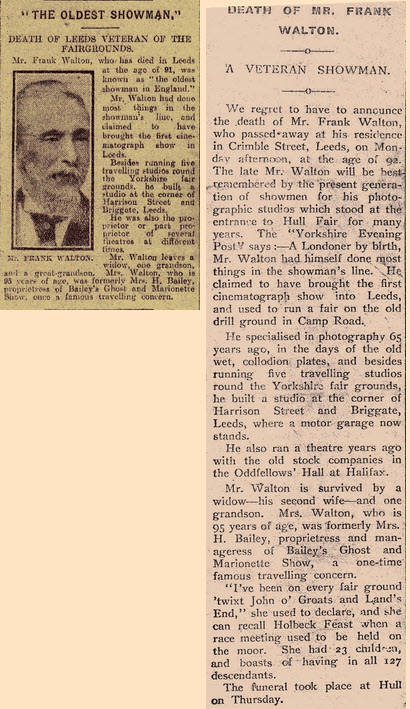
Obituaries – Frank Walton – the oldest showman – 1923
1926 Mary outlived him by nearly three years, having been virtually bed-ridden since 1915, dying also of heart failure and fooling everyone from the local council, King George V, the Yorkshire press and the many friends and descendants that she had, in fact, reached the age of 105 years (having received two telegrams from the King which she claimed to wrap in a silk handkerchief given to her by Victoria at her coronation in 1837!), when actually…. she was only really 85 years old. Always the show woman to the end
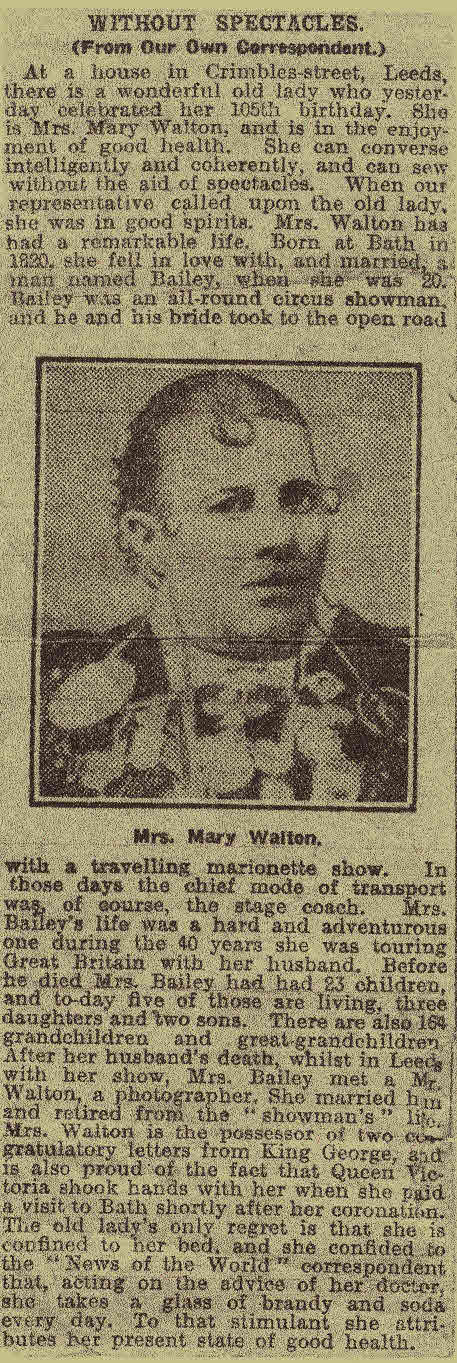
Mary Walton Interview
Related photographers
- Robert Hammond, Frank Walton’s brother in law, with studios in various towns in Lancashire. Robert was Frank’s first wife’s half brother
- John William Hammond, Frank Walton’s nephew, with studio in Bacup. Died 1901 in workhouse at Haslingdon.
- Henry Hammond, Frank Walton’s brother in law, with studios in Mexborough and Kingston upon Hull
- William Henry Hammond (born 1872 Bingley, Yorkshire) son of Henry Hammond (wife Lily Elizabeth Bailey, daughter of Mary Walton nee Bailey)
- Emily H Walton, Frank’s daughter, jointly ran Frank’s studio in Boston, Lincolnshire
- Louisa Walton, Frank’s daughter, jointly ran Frank’s studio in Boston, Lincolnshire
- John Thomas Stewart of Bicester, a brother of Frank’s brother in law Stephen Stewart
~~~~~~~~~~~~~~~~~~~~~~~~~~~~~~~~~~~~~~~
Frank Walton’s Family
Father John Walton, born 1804 (place unknown). Lived in London 1820-1860
Mother Mary Anne May Walton. Born 1805 Islington, Middlesex. Died in childbirth 1840 aged 35 years.
Step-mother Mrs Ann May (nee Suett). Married John Walton in 1842
step sister – Mary Ann Walton – born/died 1842
step sister – Marian Sarah Walton – born 1844 died 1930
Frank
Born 12 October 1833 – Frog lane, Islington, Middlesex
Baptised 24 May 1834 St Mary’s Church, Islington, Middlesex
Married (1) 3 March 1858 to Mary Anne Reeve Shaw (1834 -1893) in Kings Lynn, Norfolk
Child 1 Louisa Walton – born 1859 Coventry, Warwickshire. Died 1900 West Ham, London
Child 2 Emily Walton – born 1862 Gainsborough, Lincolnshire. Died 1888 Kingston upon Hull
Married (2) 22 March 1894 to Mary Ann Bailey, widow of Henry Bailey (nee Brewer) (1840 – 1925)
Died 5 February 1923 at Leeds of old age and heart failure, age 91 years.
~~~~~~~~~~~~~~~~~~~~~~~~~~~~~~~~~~~~~~~
Compiled by Ron Cosens © www.cartedevisite.co.uk
Sources
- Peter Leonard – pleonard1@mmm.com – family historian
- Sandy Barrie for trade directory information
- Marcel Safier for additional research
- Ron Cosens for images from the Victorian Image Collection
~~~~~~~~~~~~~~~~~~~~~~~~~~~~~~~~~~~~~~~
Frank Walton – Gallery
Examples of Frank’s photography are shown below.
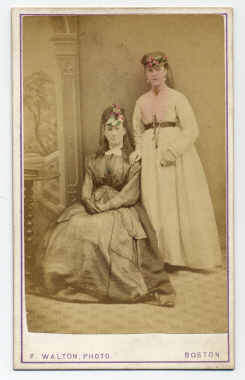 Frank Walton carte de visite photograph 1 |
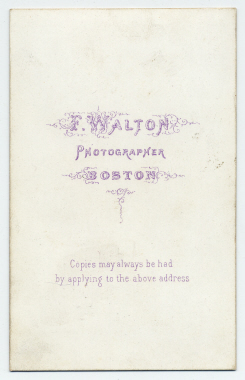 Frank Walton carte de visite photograph 1 (verso) |
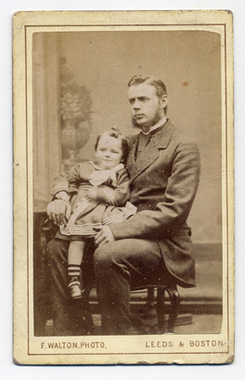 Frank Walton carte de visite photograph 2 |
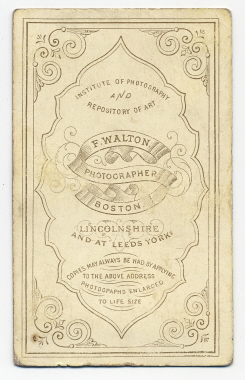 Frank Walton carte de visite photograph 2 (verso) |
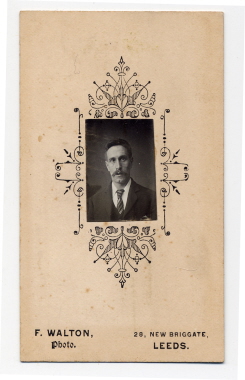 Frank Walton carte de visite photograph 3 |
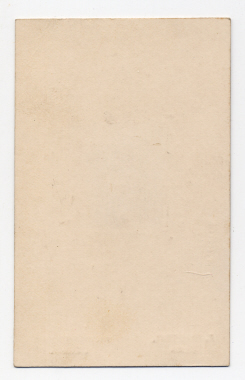 Frank Walton carte de visite photograph 3 (verso) |
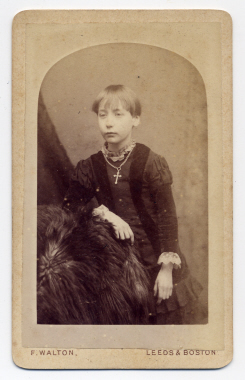 Frank Walton carte de visite photograph 4 |
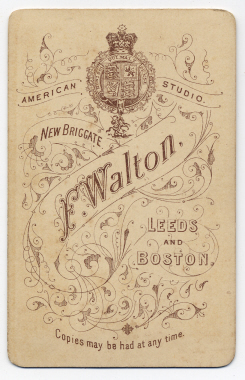 Frank Walton carte de visite photograph 4 (verso) |
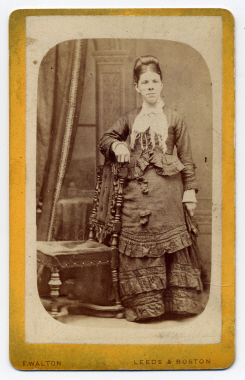 Frank Walton carte de visite photograph 5 |
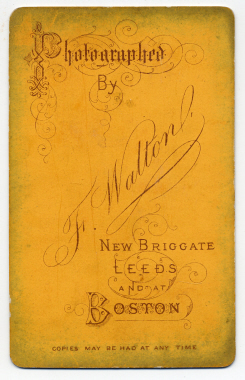 Frank Walton carte de visite photograph 5 (verso) |
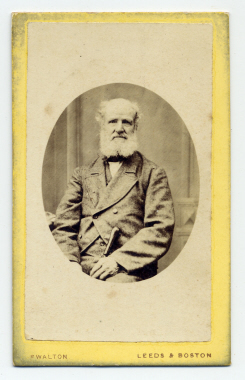 Frank Walton carte de visite photograph 6 |
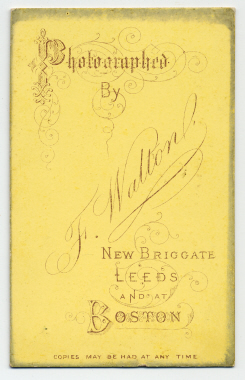 Frank Walton carte de visite photograph 6 (verso) |
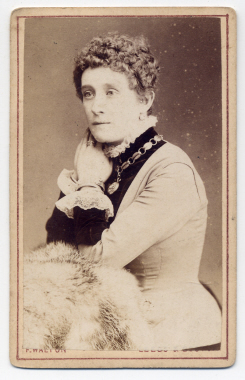 Frank Walton carte de visite photograph 7 |
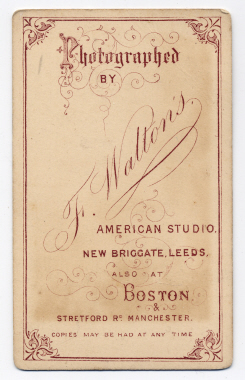 Frank Walton carte de visite photograph 7 (verso) |
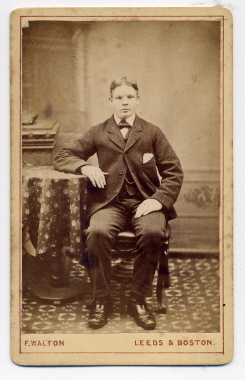 Frank Walton carte de visite photograph 8 |
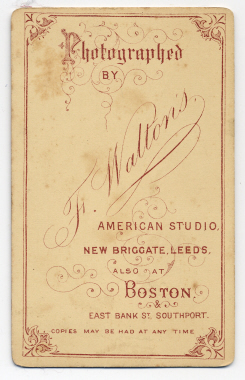 Frank Walton carte de visite photograph 8 (verso) |
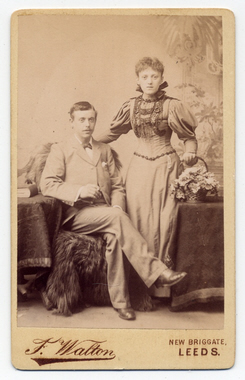 Frank Walton carte de visite photograph 9 |
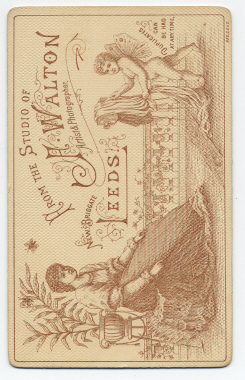 Frank Walton carte de visite photograph 9 (verso) |
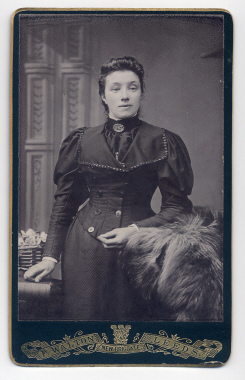 Frank Walton carte de visite photograph 10 |
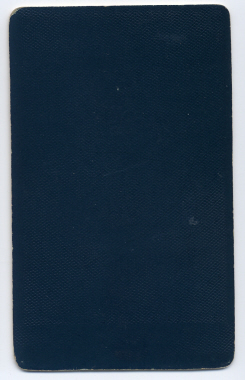 Frank Walton carte de visite photograph 10 (verso) |
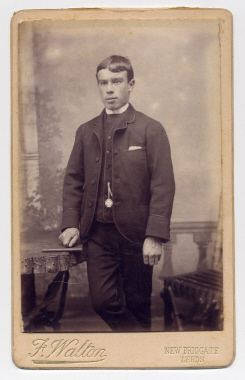 Frank Walton carte de visite photograph 11 |
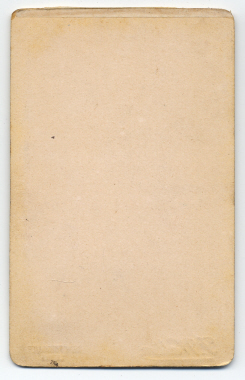 Frank Walton carte de visite photograph 11 (verso) |
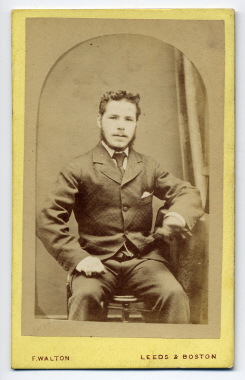 Frank Walton carte de visite photograph 12 |
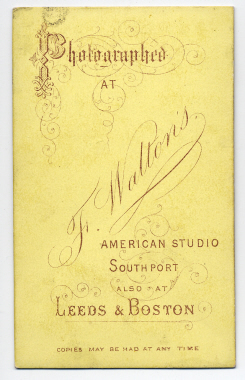 Frank Walton carte de visite photograph 12 (verso) |
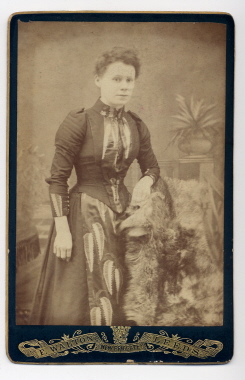 Frank Walton carte de visite photograph 13 |
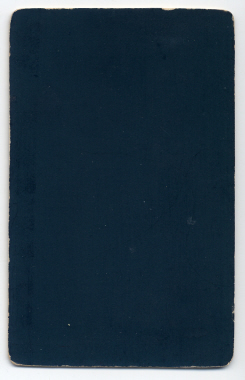 Frank Walton carte de visite photograph 13 (verso) |
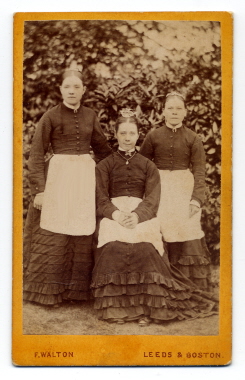 Frank Walton carte de visite photograph 14 |
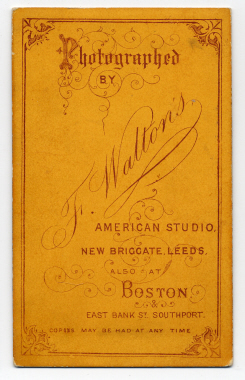 Frank Walton carte de visite photograph 14 (verso) |
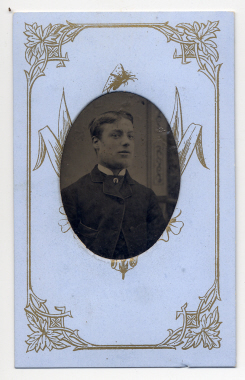 Frank Walton tintype photograph 15 |
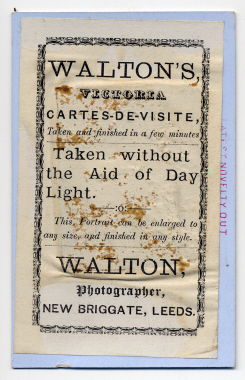 Frank Walton tintype photograph 15 (verso) |
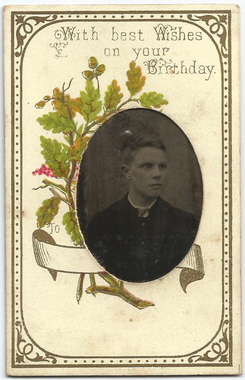 Frank Walton tintype – photograph 16 |
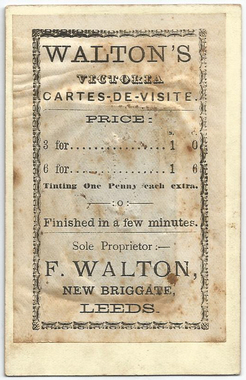 Frank Walton tintype – photograph 16 (verso) |

